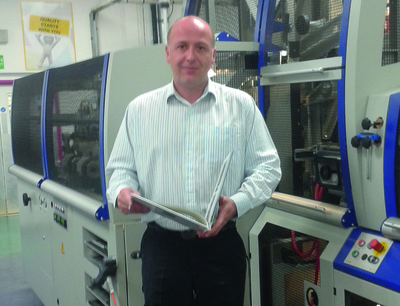James Belton, operational planning and solutions manager at Harrier, with the Kolbus case binding line
Harrier LLC invested in a sophisticated case binding line last year, partly to offer services to the trade. Andy Knaggs discovers that it is going well so far.
Harrier LLC is enjoying that warm, fuzzy feeling of a plan coming together. Last year, the Devon print operation added a Kolbus case-making and casing-in line to its battery of eight HP Indigo presses, in a £1 million investment that it hoped would support and accelerate growth in its photobook and trade book printing services.
It reckoned that with many digital print businesses not being of sufficient size to warrant real top-end book making equipment, the Kolbus DA260 and BF512 machines would give it a real unique selling point in the market place. And it seems to be panning out like that, according to Julian Marsh, who is responsible for commercial business development at the Newton Abbott firm.
He told Digital Printer: ‘It does seem that way. There are print companies out there with similar equipment but mainly to produce their offset or web produced sections, so digital really plays second fiddle as far as production is concerned. We’ve not really found anyone competing from a digital point of view. Once it became common knowledge that we had the equipment, we started getting enquiries from people we’d never heard of. Probably 200 publishers, or printers on behalf of publishers, that recognised that the kit we have got is an opportunity for them.
‘The response has been very good: 50% of the enquiries now are word of mouth. We sponsored the book category at the Digital Printer Awards, and just by itself that generated quite a bit of interest. It was a good platform because people asked “why are you doing that?”.’
With a sweet spot for digitally-printed books of anywhere between runs of 50 and 1000 copies (Harrier would use it for more than 1000 copies for offset-printed work), the Kolbus line is now handling about 10,000 hard back books per week. This is spread between Harrier’s photobook work (such as for Snapfish, Tesco and Funky Pigeon) and commercial trade work, for which Harrier looks to turnaround case bound books in five working days from proof approval to despatch.
The expectation is that at peak period in the run up to Christmas, the volumes will increase to 20,000 books per week. It was this factor that really made the company sit and think hard about its book binding capacity in the lead up to the investment. Should it buy additional smaller units to augment its existing Darix case-making and ODM casing-in machinery, or really make a statement with the Kolbus line?
‘The decision was made to go with Kolbus so that we would not have to train up lots of people to cope with the peak; we could do it on one machine,’ said Mr Marsh. ‘Kolbus stands for quality in the casing-in market and, for us, having something that we know will deliver in our peak period is critically important.’
Having installed the line, things are not standing still. One attraction of the Kolbus machinery was its modular nature, which allows more features to be added as time passes. Harrier is to put a stacker on the back end to help deal with the 30 books per minute output more efficiently. The decision has also been made to put a Kolbus board cutter in, so that grey boards can be cut to size offline without having to order them pre-cut or use a guillotine, which creates a lot of dust and blunts blades. Harrier’s US parent company has installed a Kolbus line equipped with a three-knife trimmer and a KM200 multi-clamp PUR binder, and as the UK books business grows, these may also be added to the line in Devon.
Away from the Kolbus line, the company has ordered a Newbind Endsheeter from Encore Machinery, manufactured in Italy by 4B-Four Bind, to do ‘end-sheet combining’. It is receiving a lot of yearbook work and generally finding that it is losing some of the spine when 4-page end papers go through the guillotine.
‘This Newbind machine combines two 4-page end papers onto a tape so you don’t lose anything out of the spine. It’s something that customers are asking for and if enough customers are prepared to pay to justify the investment, then this company will make the investment. We struggled to find a trade finisher that could do that for us,’ said Mr Marsh.
The company is experiencing growth across its photobook and commercial trade work, while digital print is opening up exciting new avenues for publishers – for a printer such as Harrier that also makes the future exciting.





